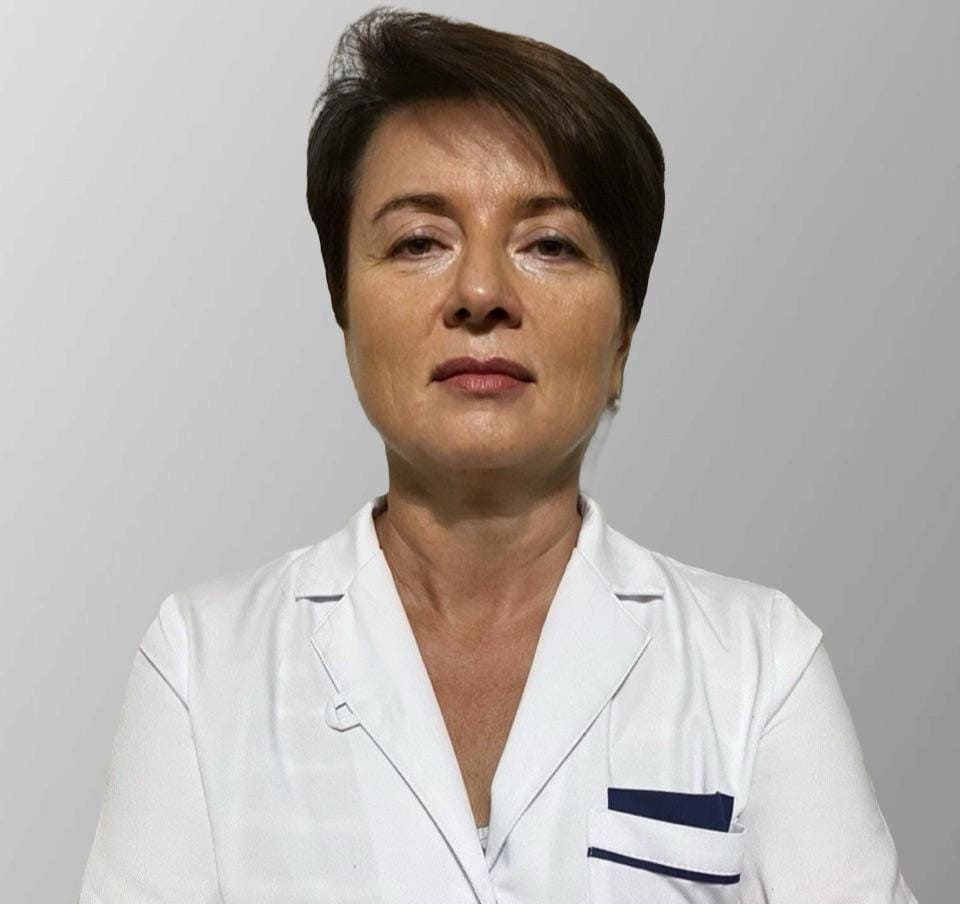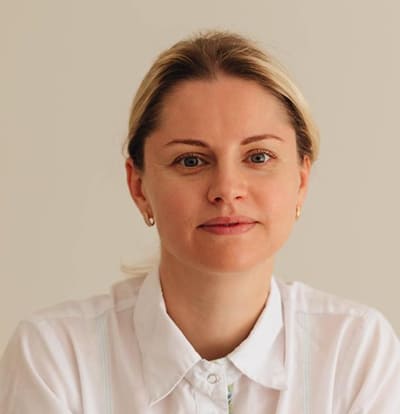
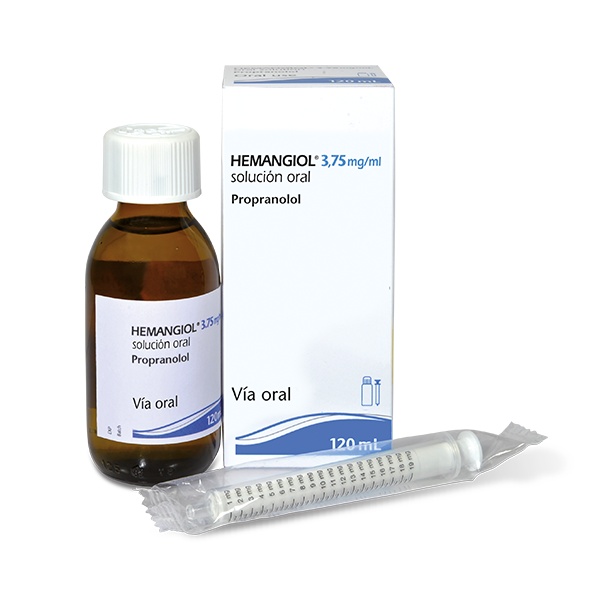
HEMANGIOL 3,75 mg/ml SOLUÇÃO ORAL

Pergunte a um médico sobre a prescrição de HEMANGIOL 3,75 mg/ml SOLUÇÃO ORAL

Como usar HEMANGIOL 3,75 mg/ml SOLUÇÃO ORAL
Introdução
Prospecto: informação para o utilizador
HEMANGIOL 3,75 mg/ml, solução oral
propranolol
Leia todo o prospecto atentamente antes de o seu filho começar a tomar este medicamento, porque contém informações importantes para si.
- Conserva este prospecto, porque pode ter que o ler novamente.
- Se tiver alguma dúvida, consulte o seu médico ou farmacêutico.
- Este medicamento foi prescrito apenas para o seu filho e não deve ser dado a outras pessoas, embora tenham os mesmos sintomas que o seu filho, porque pode prejudicá-las.
- Se o seu filho experimentar efeitos adversos, consulte o seu médico ou farmacêutico, mesmo que se trate de efeitos adversos que não aparecem neste prospecto. Ver seção 4.
Conteúdo do prospecto
- O que é HEMANGIOL e para que é utilizado
- O que precisa saber antes de o seu filho começar a tomar HEMANGIOL
- Como tomar HEMANGIOL ao seu filho
- Posíveis efeitos adversos
- Conservação de HEMANGIOL
- Conteúdo do envase e informações adicionais
1. O que é HEMANGIOL e para que é utilizado
O que é HEMANGIOL
O nome do seu medicamento é HEMANGIOL. O princípio ativo é propranolol.
O propranolol pertence a um grupo de medicamentos conhecidos como betabloqueantes.
Para que é utilizado
Este medicamento é utilizado para tratar uma doença chamada hemangioma. Um hemangioma é um acúmulo extra de vasos sanguíneos que formaram um bulto na pele ou debaixo da mesma. O hemangioma pode ser superficial ou profundo. Às vezes é chamado de “marca de morango” porque a superfície de um hemangioma se assemelha um pouco a um morango.
Hemangiol é iniciado em crianças que têm desde 5 semanas até 5 meses de idade, quando:
- a localização e/ou a extensão das lesões colocam em perigo a vida ou a função de um órgão (podem alterar órgãos vitais ou sentidos como a visão ou a audição);
- o hemangioma está ulcerado (ou seja, ferida na pele que não se cura) e é doloroso, e/ou não responde a medidas básicas de cuidado de feridas;
- há risco de cicatrizes permanentes ou desfiguração.
2. O que precisa saber antes de o seu filho começar a tomar HEMANGIOL
Não use HEMANGIOL
Se o seu filho:
- nasceu prematuramente e não alcançou a idade corrigida de 5 semanas (a idade corrigida é a idade que teria um lactente prematuro se tivesse nascido na data prevista);
- é alérgico ao propranolol ou a qualquer um dos outros componentes deste medicamento (incluídos na seção 6). Uma reação alérgica pode incluir uma erupção cutânea, coceira ou dificuldade respiratória;
- tem asma ou antecedentes de dificuldades respiratórias;
- tem uma frequência cardíaca lenta para a sua idade. Deve consultar com o seu médico se não tiver certeza;
- tem um problema cardíaco (como distúrbios do ritmo cardíaco e insuficiência cardíaca);
- tem uma pressão arterial muito baixa;
- tem problemas circulatórios que fazem com que os dedos dos pés e das mãos fiquem entorpecidos e pálidos;
- tem propensão a uma concentração baixa de açúcar no sangue;
- tem a pressão arterial elevada por um tumor da glândula suprarrenal. Isso é chamado de “feocromocitoma”.
Se você está amamentando o seu filho e se está tomando medicamentos que não devem ser utilizados com HEMANGIOL (ver “Se está amamentando o seu filho” e “Uso de HEMANGIOL com outros medicamentos”), não administreeste medicamento ao seu filho.
Advertências e precauções
Antes de o seu filho começar a tomar HEMANGIOL, informe o seu médico:
- se o seu filho tem problemas de fígado ou rins. Este medicamento não é recomendado em caso de insuficiência hepática ou renal;
- se o seu filho já teve alguma vez uma reação alérgica, qualquer que seja a sua origem (por exemplo, medicamentos ou substâncias alimentícias, etc.). Uma reação alérgica pode incluir uma erupção cutânea, coceira ou dificuldade respiratória;
- se o seu filho tem psoríase (uma doença da pele que produz placas vermelhas e secas de pele endurecida), porque este medicamento pode piorar os sintomas desta doença;
- se o seu filho tem diabetes: nesse caso, deve aumentar a frequência de monitorização da glicose sanguínea do seu filho.
- se o seu filho tem síndrome PHACE (um distúrbio que combina hemangioma e malformações vasculares que podem afetar os vasos sanguíneos cerebrais), porque este medicamento pode aumentar o risco de acidente vascular cerebral.
Signos importantes que se devem procurar após a administração de HEMANGIOL
Riscos de hipoglicemia
Este medicamento pode mascarar os sinais de alarme da hipoglicemia (também conhecida como concentração baixa de açúcar no sangue). Também pode agravar a hipoglicemia em crianças, especialmente durante o período de jejum (por exemplo, má ingestão de alimentos por via oral, infecção, vômitos), quando aumentam as demandas de glicose (resfriado, estresse, infecções), ou em caso de sobredose. Estes sinais podem ser:
- Leves: palidez, cansaço, suor, tremor, palpitações, ansiedade, fome, dificuldade para levantar-se.
- Graves: sonolência excessiva, dificuldade para responder, problemas para alimentar, diminuição da temperatura corporal, convulsões (crise), pausas breves na respiração, perda de consciência.
O risco de desenvolver hipoglicemia se mantém elevado durante todo o período de tratamento.
Para evitar os riscos de hipoglicemia,deve administrar HEMANGIOL durante ou imediatamente após uma refeição e evitar administrar a última dose perto da hora de dormir à noite (ver seção 3).Deve alimentarsuficientemente ecom frequência o seu filho durante o tratamento. Se o seu filho não come suficiente, se apresenta outra doença ou se vomita, se recomenda omitir a dose. NÃO ADMINISTRE HEMANGIOL AO SEU FILHO ATÉ QUE SEJA ALIMENTADO CORRETAMENTE. Se o seu filho tiver algum sinal de hipoglicemia enquanto toma HEMANGIOL,interrompa o tratamento e ligue rapidamente ao seu médico ou vá diretamente ao hospital. Se a criança estiver consciente,administre-lhe um líquido oral que contenha açúcar. |
Riscos de broncoespasmo
Interrompa o tratamento e entre em contato imediatamente com um médico se, após administrar HEMANGIOL ao seu filho, observar os seguintes sintomas indicativos de broncoespasmo (restrição transitória dos conductos bronquiais que produz dificuldade respiratória): tosse, respiração rápida ou difícil ou sibilância, associados ou não a pele de cor azulada.
Interrompa o tratamento e entre em contato imediatamente com um médico se o seu filho tiver sintomas semelhantes ao resfriado associados com dificuldade para respirar e/ou sibilância enquanto tomaHEMANGIOL. |
Risco de hipotensão e bradicardia (frequência cardíaca lenta)
HEMANGIOL pode reduzir a pressão arterial (hipotensão) e a frequência cardíaca (bradicardia). Por este motivo, o seu filho deve estar sob uma estreita monitorização clínica e da frequência cardíaca durante 2 horas após a primeira tomada e após um aumento da dose. Posteriormente, durante o tratamento, o seu médico realizará exames clínicos periódicos ao seu filho.
Interrompa o tratamento e entre em contato imediatamente com um médico se o seu filho tiver qualquer sinal como cansaço, sensação de frio, palidez, coloração azulada da pele ou desvanecimento enquanto tomaHEMANGIOL. |
Risco de hiperpotassemia
HEMANGIOL pode aumentar a concentração sanguínea de potássio (hiperpotassemia). Em caso de hemangioma ulcerado grande, deve medir a concentração sanguínea de potássio do seu filho.
Se o seu filho for submetido a anestesia geral
Informa ao seu médico que o seu filho está tomando HEMANGIOL. Isso se deve ao fato de o seu filho poder ter a pressão arterial baixa se lhe forem administrados determinados anestésicos enquanto toma este medicamento (ver “Uso de HEMANGIOL com outros medicamentos”). Pode ser necessário interromper HEMANGIOL pelo menos 48 horas antes da anestesia.
Se está amamentando o seu filho
- Informa ao seu médico antes de administrar este medicamento.
- Não administre este medicamento ao seu filho se você estiver tomando medicamentos que não devem ser utilizados com HEMANGIOL (ver “Uso de HEMANGIOL com outros medicamentos”).
Uso de HEMANGIOL com outros medicamentos
- Informa ao seu médico, farmacêutico ou enfermeiro se está administrando, administrou recentemente ou pode ter que administrar qualquer outro medicamento ao seu filho. Isso se deve ao fato de HEMANGIOL poder modificar a forma como outros medicamentos atuam, e alguns medicamentos podem influir na forma como HEMANGIOL atua.
- Além disso, se está amamentando o seu filho, é importante que informe ao seu médico, farmacêutico ou enfermeiro dos medicamentos que está tomando, porque podem passar para o leite materno e interferir com o tratamento do seu filho. O seu médico aconselhará se é necessário interromper a amamentação ou não.
Em particular, no caso de estar amamentando o seu filho, informe ao seu médico ou farmacêutico se você ou o seu filho está tomando:
- medicamentos para a diabetes;
- medicamentos para problemas do coração e dos vasos sanguíneos, como batimentos cardíacos irregulares, dor no peito ou angina, pressão arterial elevada ou insuficiência cardíaca;
- medicamentos para tratar a ansiedade e a depressão, além de problemas mais graves de saúde mental, e a epilepsia;
- medicamentos para tratar a tuberculose;
- medicamentos para tratar a dor e a inflamação;
- medicamentos utilizados para reduzir as gorduras no sangue;
- medicamentos utilizados para a anestesia.
Se tiver alguma outra pergunta, consulte o seu médico ou farmacêutico.
HEMANGIOL contém sódio e propilenoglicol
Este medicamento contém menos de 23 mg de sódio (1mmol) por dose; isto é, é essencialmente “isento de sódio”.
Este medicamento contém 2,08 mg de propilenoglicol/kg/dia. Se o bebê tiver menos de 4 semanas de idade, consulte o seu médico ou farmacêutico, em particular se ao bebê foram administrados outros medicamentos que contenham propilenoglicol ou álcool.
3. Como administrar HEMANGIOL ao seu filho
O tratamento do seu filho foi iniciado por um médico que tem experiência no diagnóstico, tratamento e manejo do hemangioma infantil.
Siga exatamente as instruções de administração ao seu filho deste medicamento indicadas pelo seu médico ou farmacêutico. Em caso de dúvida, consulte novamente o seu médico ou farmacêutico.
Nunca modifique você mesmo a dose que está administrando ao seu filho. Todos os aumentos de dose e todos os ajustes pelo peso do seu filho devem ser realizados pelo seu médico.
Dose
- A dose é baseada no peso da criança seguindo o seguinte esquema:
Semanas (dose diária) | Dose por tomada | Horas das tomadas |
Primeira semana (1 mg/kg/dia) | 0,5 mg/kg |
|
Segunda semana (2 mg/kg/dia) | 1mg/kg | |
Terceira e semanas seguintes (3 mg/kg/dia) | 1,5 mg/kg |
.
- Quando necessário, pode diluir o medicamento em uma pequena quantidade de leite infantil ou de suco de maçã e/ou de laranja adaptado para a idade da criança, e administrá-lo ao seu filho em um biberão. Não misture o medicamento diretamente com um biberão cheio de leite ou suco.
Para crianças de até 5 kg de peso, pode misturar a dose com uma colher de chá de leite infantil (aproximadamente 5 ml). Para crianças de mais de 5 kg de peso, pode misturar a dose com uma colher de sopa de leite infantil ou suco de fruta (aproximadamente 15 ml).
Use a mistura nas 2 horas seguintes à sua preparação.
Como administrar HEMANGIOL ao seu filho
- Hemangiol é para via oral.
- O medicamento deve ser administrado durante a alimentação da criança ou imediatamente após a mesma.
- A dose sempre deve ser medida com a seringa oral que se fornece com o frasco.
- Administre HEMANGIOL diretamente na boca do seu filho utilizando a seringa para uso oral que se inclui com o frasco.
- Alimente com frequência o seu filho para evitar o jejum prolongado.
- Se o seu filho não come, ou se vomita, se recomenda omitir a dose.
- Se o seu filho vomitar uma dose, ou se não estiver seguro de que recebeu todo o medicamento, não lhe administre outra dose, simplesmente espere até a próxima dose programada.
- Uma mesma pessoa deve administrar HEMANGIOL e a alimentação da criança a fim de evitar o risco de hipoglicemia. Se participam pessoas diferentes, é essencial uma boa comunicação para garantir a segurança do seu filho.
Instruções de uso:
- Paso 1. Extraia do estojo os diferentes elementos
O estojo contém os seguintes elementosque precisará para administrar o medicamento:
- O frasco de vidro contendo 120 ml de solução oral de propranolol.
- A seringa para uso oral dosificadora em mg que se inclui com este medicamento.
Extraia do estojo o frasco e a seringa para uso oral, e retire a seringa da bolsa de plástico.
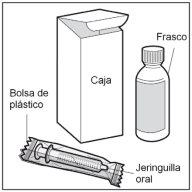
- Paso 2. Verifique a dose
Verifique a dose de HEMANGIOL em miligramas (mg) tal como a prescreveu o seu médico.
Localize este número na seringa para uso oral.
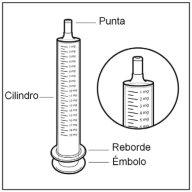
- Paso 3. Abra o frasco
O frasco tem um tampão à prova de crianças. Esta é a maneira de abri-lo: aperte para baixo o tampão de plástico ao mesmo tempo que gira o tampão no sentido contrário ao dos ponteiros do relógio (para a esquerda).
Não agite o frasco antes de usá-lo.
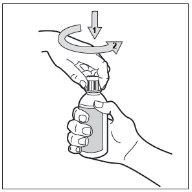
- Paso 4. Introduza a seringa
Introduza a ponta da seringa para uso oral no frasco em posição vertical, e empurre o émbolo em todo o seu percurso.
Não retire o adaptador para a seringa da boca do frasco.
Use apenas a seringa para uso oral que se fornece com o medicamento para medir e administrar a dose. Não use uma colher nem qualquer outro dispositivo dispensador.
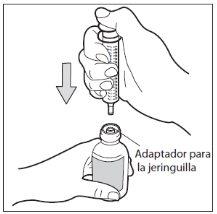
- Paso 5: Extraia a dose
Com a seringa para uso oral colocada, gire o frasco para colocá-lo boca abaixo. Puxe o émbolo da seringa até o número de mg que precisa.
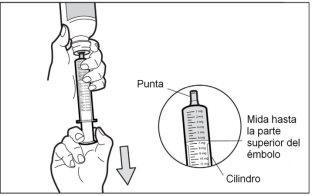
- Paso 6: Verifique a ausência de bolhas de ar
Se vir bolhas de ar na seringa, segure a seringa verticalmente, empurre o émbolo para cima o suficiente para expulsar completamente todas as bolhas de ar grandes, e ajuste-o até a dose prescrita pelo médico.
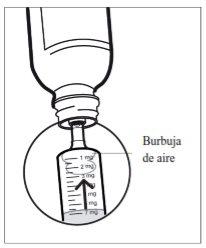
- Paso 7. Extraia a seringa
Gire o frasco para colocá-lo em posição vertical, e separe do frasco toda a seringa. Tenha cuidado para não empurrar o émbolo durante este passo.
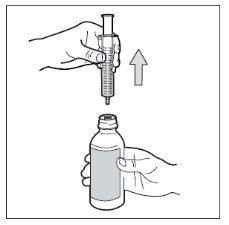
- Paso 8. Feche o frasco
Volte a colocar o tampão de plástico no frasco girando-o no sentido dos ponteiros do relógio (para a direita).
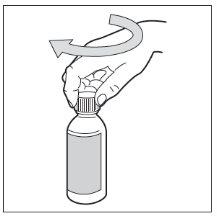
- Paso 9. Administre HEMANGIOL ao seu filho
Introduza a seringa na boca do seu filho e apoie-a na parte interna da bochecha.
Agora já pode expulsar lentamente HEMANGIOL desde a seringa diretamente na boca do seu filho.
Não deite a criança imediatamente após administrar o medicamento.
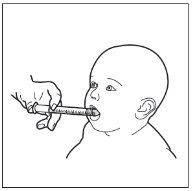
- Paso 10: Limpe a seringa.
Não desmonte a seringa. Clare a seringa vazia em um copo de água limpa após cada uso:
1- Pegue um copo de água limpa
2- Puxe o émbolo até o extremo
3- Jogue a água no ralo
4- Repita 3 vezes este processo de limpeza.
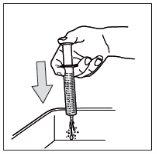
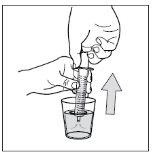
Não use nenhum produto com sabão ou álcool para limpá-la. Seque o exterior com um pano. Não introduza a seringa em um esterilizador nem em uma máquina de lavar louça.
Guarde o frasco e a seringa juntos no estojo até o próximo uso, em um local seguro onde a criança não possa vê-lo ou ao qual não possa chegar. Jogue a seringa quando o frasco estiver vazio.
Se administrar ao seu filho mais HEMANGIOL do que deve
Se administrar ao seu filho mais HEMANGIOL do que deve, consulte imediatamente o seu médico.
Se esquecer de administrar HEMANGIOL ao seu filho
Omita a dose esquecida, e não administre uma dose dupla para compensar as doses esquecidas. Continue o tratamento com a frequência habitual. Uma dose de manhã e outra ao final da tarde.
Se interromper o tratamento do seu filho com HEMANGIOL
HEMANGIOL pode deixar de ser administrado de repente no final do tratamento, segundo o decidir o médico.
Se tiver alguma outra dúvida sobre o uso deste medicamento, pergunte ao seu médico ou farmacêutico.
4. Efeitos adversos possíveis
Tal como todos os medicamentos, este medicamento pode produzir efeitos adversos, embora nem todas as pessoas os sofram.
Além disso, após a administração de HEMANGIOL, devem ser procurados importantes sinais de alarme de possíveis efeitos adversos, como pressão arterial baixa, frequência cardíaca baixa, concentração de açúcar no sangue baixa ou broncoespasmo (dificuldades para respirar). Ver seção 2 deste prospecto.
Efeitos adversosmuito frequentes (podem afetar mais de 1 de cada 10 pessoas):
- bronquite (inflamação dos brônquios),
- distúrbios do sono (insónia, sono de má qualidade e dificuldade para acordar),
- diarreia e vômitos.
Efeitos adversosfrequentes (podem afetar até 1 de cada 10 pessoas):
- broncoespasmo (dificuldade respiratória),
- bronquiolite (inflamação de brônquios pequenos com dificuldade respiratória e sibilância no peito, associada a tosse e febre),
- diminuição da pressão arterial,
- diminuição do apetite,
- agitação, pesadelos, irritabilidade,
- sonolência,
- extremidades frias,
- constipação, dor abdominal,
- eritema (vermelhidão cutânea).
- Dermatite do fraldão.
Efeitos adversospouco frequentes (podem afetar até 1 de cada 100 pessoas):
- distúrbios de condução ou do ritmo cardíaco (batimentos cardíacos lentos ou irregulares),
- urticária (reação alérgica da pele), alopecia (perda de cabelo),
- diminuição da concentração de açúcar no sangue,
- redução do número de leucócitos (células da série branca no sangue).
A frequência dos seguintes efeitos adversos édesconhecida (não pode ser estimada a partir dos dados disponíveis)
- convulsões (crises) relacionadas com a hipoglicemia (concentração anormalmente baixa de glicose no sangue),
- bradicardia (frequência cardíaca anormalmente baixa),
- pressão arterial baixa,
- números muito baixos de leucócitos (células da série branca no sangue) que lutam contra as infecções,
- problemas circulatórios que fazem com que os dedos dos pés e das mãos estejam entorpecidos e pálidos,
- elevação da concentração de potássio no sangue.
Comunicação de efeitos adversos
Se seu filho experimentar qualquer tipo de efeito adverso, consulte seu médico ou farmacêutico, mesmo que se trate de efeitos adversos que não aparecem neste prospecto. Também pode comunicá-los diretamente através do sistema nacional de notificação incluído no Apêndice V. Mediante a comunicação de efeitos adversos, você pode contribuir para fornecer mais informações sobre a segurança deste medicamento.
5. Conservação de HEMANGIOL
Mantenha este medicamento fora da vista e do alcance das crianças.
Não utilize este medicamento após a data de validade que aparece na caixa e na etiqueta do frasco. A data de validade é o último dia do mês que se indica.
Conservar o frasco no embalagem exterior para protegê-lo da luz. Guardar o frasco e a seringa para uso oral no estojo entre cada uso. Não congelar.
Após a primeira abertura do frasco, o medicamento deve ser usado em um prazo máximo de 2 meses.
Os medicamentos não devem ser jogados nos deságues nem na lixeira. Pergunte ao seu farmacêutico como se livrar dos envases e dos medicamentos que já não precisa. Dessa maneira, você ajudará a proteger o meio ambiente.
6. Conteúdo do envase e informações adicionais
Composição de HEMANGIOL
- O princípio ativo é propranolol. Cada ml contém 4,28 mg de hidrocloruro de propranolol, equivalente a 3,75 mg/ml de propranolol.
- Os demais ingredientes são hidroxietilcelulose, sacarina sódica, aroma fresa (contém propilenoglicol), aroma baunilha (contém propilenoglicol), ácido cítrico monohidratado e água purificada. Para mais informações, consulte a seção 2 em "HEMANGIOL contém sódio e propilenoglicol".
Aspecto de HEMANGIOL e conteúdo do envase
- HEMANGIOL é uma solução oral transparente, incolor ou de um color ligeiramente amarelo, com odor afrutado.
- É fornecido em um frasco de vidro de cor âmbar de 120 ml, com um tampão de rosca à prova de crianças. Envase de 1 frasco.
- Com cada frasco é fornecida uma seringa para uso oral de polipropileno dosificadora em mg de propranolol.
Titular da autorização de comercialização
PIERRE FABRE MEDICAMENT
Les Cauquillous
81500 Lavaur
FRANÇA
Responsável pela fabricação
FARMEA
10 rue Bouché Thomas
ZAC Sud d’Orgemont
49000 ANGERS
FRANÇA
O
PIERRE FABRE MEDICAMENT PRODUCTION
Site PROGIPHARM, Rue du Lycée
45500 GIEN
FRANÇA
Podem solicitar mais informações sobre este medicamento dirigindo-se ao representante local do titular da autorização de comercialização.
Data da última revisão deste prospecto:
A informação detalhada sobre este medicamento está disponível na página web da Agência Europeia de Medicamentos: http://www.ema.europa.eu.

Quanto custa o HEMANGIOL 3,75 mg/ml SOLUÇÃO ORAL em Espanha em 2025?
O preço médio do HEMANGIOL 3,75 mg/ml SOLUÇÃO ORAL em dezembro de 2025 é de cerca de 225.59 EUR. Os valores podem variar consoante a região, a farmácia e a necessidade de receita. Confirme sempre com uma farmácia local ou fonte online para obter informações atualizadas.
- País de registo
- Preço médio em farmácia225.59 EUR
- Substância ativa
- Requer receita médicaSim
- Fabricante
- Esta informação é apenas para referência e não constitui aconselhamento médico. Consulte sempre um médico antes de tomar qualquer medicamento. A Oladoctor não se responsabiliza por decisões médicas baseadas neste conteúdo.
- Alternativas a HEMANGIOL 3,75 mg/ml SOLUÇÃO ORALForma farmacêutica: COMPRIMIDO, 10 mgSubstância ativa: propranololFabricante: Accord Healthcare S.L.U.Requer receita médicaForma farmacêutica: COMPRIMIDO, 40 mgSubstância ativa: propranololFabricante: Accord Healthcare S.L.U.Requer receita médicaForma farmacêutica: COMPRIMIDO, 10 mgSubstância ativa: propranololFabricante: Aurovitas Spain, S.A.U.Requer receita médica
Alternativas a HEMANGIOL 3,75 mg/ml SOLUÇÃO ORAL noutros países
As melhores alternativas com o mesmo princípio ativo e efeito terapêutico.
Alternativa a HEMANGIOL 3,75 mg/ml SOLUÇÃO ORAL em Polónia
Alternativa a HEMANGIOL 3,75 mg/ml SOLUÇÃO ORAL em Ukraine
Médicos online para HEMANGIOL 3,75 mg/ml SOLUÇÃO ORAL
Avaliação de posologia, efeitos secundários, interações, contraindicações e renovação da receita de HEMANGIOL 3,75 mg/ml SOLUÇÃO ORAL – sujeita a avaliação médica e regras locais.





